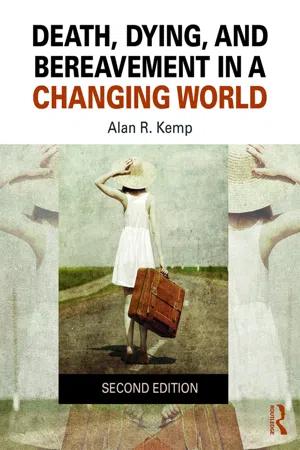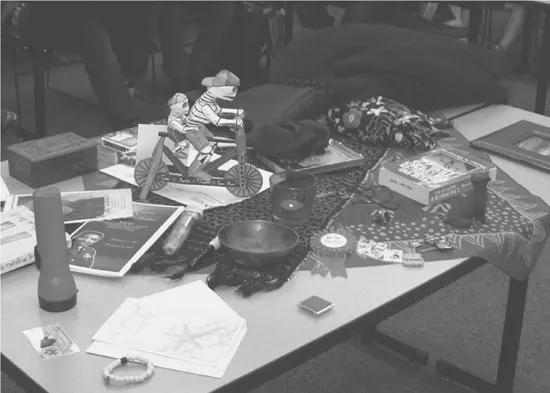![]()
PART
I
Introduction and Context
Part I consists of four chapters that introduce thanatology—the study of death, dying, and bereavement—and the social, psychological, and spiritual contexts in which we encounter them.
Chapter 1 is titled “Lifting the Pall: The Quest to Uncover Wisdom about Life Through the Study of Death.” The central metaphor of the chapter is the pall, a cloth covering placed over the casket during a funeral. To “lift the pall” is to uncover that which is beneath so that we might see it for what it is. The metaphor of the pall is also connected to anthropologist Ernest Becker’s thesis, The Denial of Death (1973), the title of the Pulitzer Prize–winning book he wrote just one year before his own death. Becker believed that the pervasive denial of death is at the root of many of society’s most pressing problems. Chapter 1 introduces thanatology as an emerging academic discipline. We will discuss the multidisciplinary, multidimensional nature of contemporary thanatology. We will also focus on the topic of death education, which can be both a formal and informal area of study, and learn about a few key figures in the death awareness movement. The tensions in the field, particularly between practitioners and academics, will be noted, and we will discuss the “conversation” between practice and research. We will also look at terror management theory, TMT, which evolved from the interest of three graduate students in the ideas of Ernest Becker. To test TMT, this team, whose members became experimental social psychologists, used rigorous experimental method, yielding very strong support for TMT and Becker’s pioneering ideas.
Chapter 2, “Death and Dying in a Rapidly Changing World,” focuses on how people’s changing experience with death has been shaped by society, science, and technology. In the classic deathbed scene, the dying individual has taken to bed and is surrounded by family and loved ones until the last breath. This kind of death may have been common “back in the day,” but today most people die in hospitals or nursing homes, often entangled in technology and surrounded by health care professionals. Although medicine was once more an art than a science, Chapter 2 will note that with modern science the field of medicine has been able to add 30 years to the average life expectancy. On the downside, the industrialization of health care has continued to grow significantly, perhaps further distancing ourselves from the human touch. The chapter observes that today people seem to be experiencing accelerated social change, perhaps moving from the modern to a postmodern era. With it, we are arguably experiencing a new social malaise. Alvin Toffler called it “future shock.”
In Chapter 3, “For Everything There Is a Season: The Developmental Context,” we will look at death and human development. We will begin by taking note of the advances of modern medicine discussed in Chapter 2. As a result, fewer young people and more old people die. We will then survey encounters with death across the life span, first looking at common causes of death in infancy, toddlerhood, and middle childhood. Next, we will examine the nature of children’s emerging consciousness about and understanding of death. We will discuss the experience of gravely ill children, taking note that their experiences seem to differ quite markedly from how well children come to think of death. Turning to youth, young adults, adults, and elders, we will review common causes of death and explore the relationship between social development and the experience of death. Finally, we come to the final stage of life. To do so, the chapter will build on a work written by Erik Erikson in collaboration with his wife, Joan, prior to his own death, called The Life Cycle Completed (Erikson, 1982; Erikson & Erikson, 1997). For people who live into their eighties and nineties, as he and his wife did, he notes that the very strengths it takes a lifetime to build all too often come undone, potentially sending the elderly person into a state of despair. According to the Eriksons, a lucky few may achieve gerotrancendence, a state of equanimity and peace, before death arrives.
“Coureurs de Bois: Cross-Cultural and Interfaith Dimension,” the title of Chapter 4, uses a French-Canadian expression that connotes the idea of travelers sharing stories about all the places they’ve been. The chapter focuses on the cross-cultural dimension of death and dying, including spirituality and religion. It introduces some basic conceptual tools for comparing cultural experiences. We will look at the relationship among culture, spirit, and death. We will also review a few theoretical perspectives about spirituality and religion before surveying five key religious perspectives on death: Judaism, Christianity, Islam, Hinduism, and Buddhism. The concept of pilgrimage, using Joseph Campbell’s metaphor of the “hero’s quest,” will be explored. Finally, we endeavor to undertake a “chautauqua,” or a sampling of teaching stories about death from diverse cultures. Woven into the discussion are excerpts from interviews with His Holiness the Dalai Lama, Hindu holy man Swami Jitatmananda, and Islamic teacher Abdul Kareem, and we reflect on the example of Father Francis Mahieu, the late abbot of Kurisumala Trappist Ashram in the south of India.
![]()
CHAPTER
1
Lifting the Pall
The Quest to Uncover Wisdom about Life Through the Study of Death
■ About Self-Care
■ Lifting the Pall
■ Death Education
■ Theory, Research, and Practice
■ What about the Denial of Death?
Encounters with death, dying, and bereavement can be the most powerful experiences we have. They can also be the most personal. Everyone dies. And, before then, most will have someone they care about die. When dealing with a topic as sensitive as this one, it may be helpful to get a sense of the depth of one’s experience. In the courses I teach, I like to do an activity called “the object exercise.” In this activity, my students and I create an “altar in the round”—a table we put in the center of the room with a cloth covering and a lit candle, to symbolize that something important is taking place. Each participant has already been asked to bring an object to the session that symbolizes death, dying, or bereavement. I explain the activity. When they feel ready to do so, each student places his or her object on the table and explains to the rest of the group why that object was chosen. It is a powerful experience that usually creates a bond. By the time everyone has shared, the participants are usually pretty moved by the personal experiences brought to the activity. It is a poignant way to begin. Read more about it in “the object exercise” activity shown in Box 1.1.
BOX 1.1
The Object Exercise
In order to help build a sense of community and give students an opportunity to express themselves about their experiences with death, dying and bereavement, I’ve adapted an exercise I learned in my own studies. I ask my students to bring in a tangible, physical object to class that symbolizes for them personally their experience with death and dying. Each student takes turns placing his or her object on a table in front of, or preferably in the center of the room, explaining the significance of the object as each person does so. It always amazes me how, by making the subject concrete this way, the class is able to partake in the rich experiences of its members. Students have a chance to share in a personal way. I’ve found that the exercise tends to foster a sense of trust and camaraderie, which deepens the classroom experience.
ABOUT SELF-CARE
Before exploring the field of thanatology—the study of death, dying, and bereavement—let’s take just a few moments to discuss self-care. Students may decide to take a course on death and dying for a variety of reasons. For some, it may be a way to come to terms with an unresolved loss. For others, the subject is important for a career goal, like becoming a physician, psychologist, counselor, social worker, chaplain, or pastor. And, for still others, the course simply fulfills a requirement, one I hope will also enrich. Whatever the reasons, when venturing into territory like this, it is wise to approach the topic respectfully. The topic of death and dying touches poignant human experience, and may have the potential to expose emotionally charged thoughts and feelings that lie just below the surface.
One of the things the object exercise makes abundantly clear is that death is a pervasive human experience. Every reader, and every student, has been and will be touched by it. For some, grief about an important loss lies close to the surface. If this is the case for you, you can expect that delving into the subject will expose your memories, thoughts, and feelings—an experience that can have both positive and negative dimensions. I encourage you to use your own support system of close friends, loved ones, and perhaps even a favorite teacher, counselor, or pastor. Don’t let the tender nature of your feelings hold you back.
Just as you may have been touched in some way by death and have had to find ways to handle its impact, people in all places and at all times have found ways to come to terms with death and dying. A friend and colleague, Dale McGinnis, was an anthropologist. I often sat in on his classes. I can recall him saying on several occasions, “Death is something that all cultures have to deal with in one way or another.” Referring to funerals, I also remember him saying, “One day we’ll all be the star of that show.” How prophetic his words were, for Dale, one of the most gifted teachers I’ve ever known, was battling terminal cancer. He died less than a year later. Fully in character, however, he refused to be the star of “that show” by not showing up. He requested that there be no service.
■ ■ ■
WOODY ALLEN
■ ■ ■
LIFTING THE PALL
The key words in the title of this chapter, lifting the pall, are pivotal to grasping its central theme: achieving a greater understanding about death occurs when we lift the shroud that covers it.
A pall is a cloth covering placed over the casket during a funeral service. The word is also used to describ...


